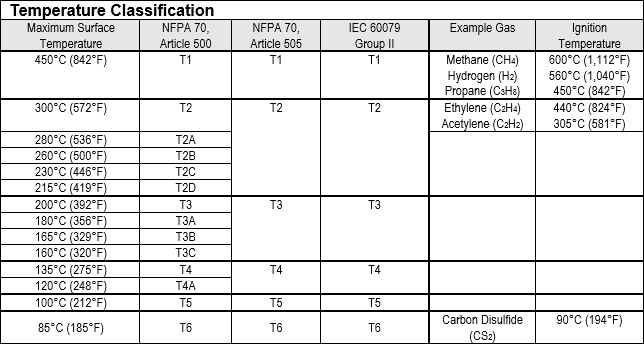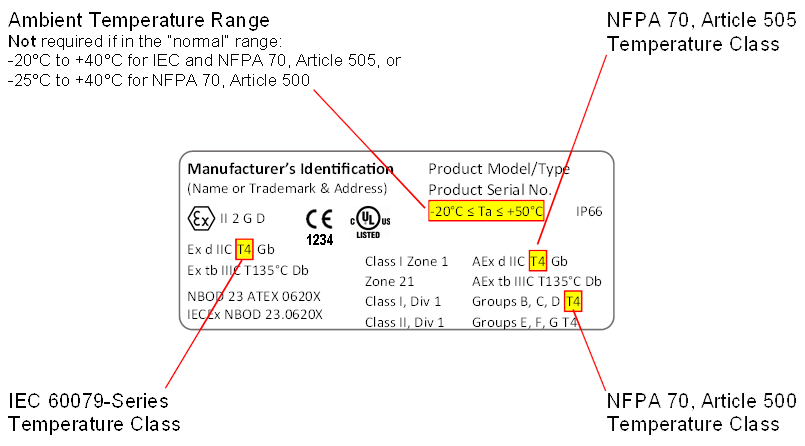The Drill Down, Issue #27: Hazardous Location Electrical Markings - Temperature Class
 Introduction
Introduction
This edition of the Drill Down on Hazardous Location (HazLoc) electrical equipment markings will focus on the temperature class designations used in National Fire Protection Association (NFPA) 70 (National Electric Code (NEC)) and the International Electrotechnical Commission (IEC) 60079-series. Temperature class is the maximum safe operating temperature of the equipment installed in HazLocs and corresponds to the ignition temperature of the substance(s) (i.e., gases) present or likely to be present in a classified location.
NFPA 70, Article 500
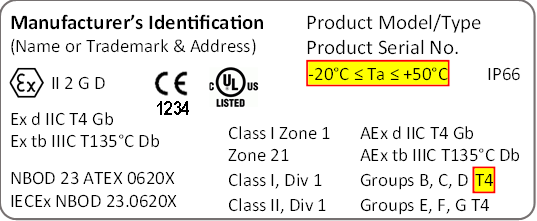 |
| Figure 1: Equipment label with NFPA 70, Article 500 temperature class & ambient temperature range indicated |
In accordance with NFPA 70 (2017), Article 500.8(C)(4)), “equipment markings shall specify the temperature class or operating temperature at a 40°C [104°F] ambient temperature, or at the higher ambient temperature if the equipment is rated and marked for an ambient temperature of greater than 40°C”. More than one temperature class (T code) or operating temperature may be marked for gases and vapors, dusts and different ambient temperatures. Figure 1 shows the temperature class to be “T4” that equates to a 135°C maximum surface temperature (see table 1).
Non-heat-producing equipment (e.g. junction boxes, conduit, fittings) and heat-producing equipment having a maximum temperature of no more than 100°C are not required to have a marked operating temperature or temperature class.
“Electrical equipment designed for use in the ambient temperature range between -25°C to +40°C shall require no ambient temperature marking. For equipment rated for a temperature range other than -25°C to +40°C, the marking shall specify the special range of ambient temperatures in degrees Celsius. The marking shall include either the symbol “Ta” or “Tamb” (NFPA 70 (2017), Article 500.8(C)(5)). The example label in figure 1 shows the ambient temperature range to be -20°C ≤ Ta ≤ +50°C and applies to all three marking systems.
There is no consistent relationship between explosion properties and ignition temperature, so they are two independent requirements (NFPA 70 (2017), Article 500.8 information note 1). As such, a temperature rating may disqualify equipment from installation within a location that it would otherwise be qualified to be installed. For example, if the label in figure 1 did not have an ambient temperature marking, the equipment would be safe within the range of -25°C to 40°C but would not be safe in a classified location with a 48°C ambient temperature. The same would be true for the varied ambient temperatures that follow for the Article 505 and IEC marking systems.
Table 1 lists the temperature classes for Article 500.
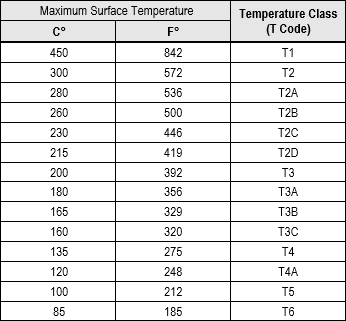 |
| Table 1: NFPA 70, Article 500 Temperature Classes |
NFPA 70, Article 505
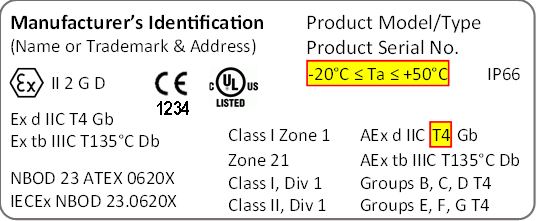 |
| Figure 2: Equipment label with NFPA 70, Article 505 temperature class & ambient temperature range indicated |
Class I (see Drill Down #24) “equipment shall be marked to show the operating temperature or temperature class referenced to a 40°C [104°F] ambient, or at the higher ambient temperature if the equipment is rated and marked for an ambient temperature of greater than 40°C” (NFPA 70 (2017), 505.9(D)(1)). The temperature marking “shall not exceed the autoignition temperature of the specific gas or vapor to be encountered” (NFPA 70 (2017), Article 505.9(D)). Figure 2 shows the temperature class to be “T4”, equating to a maximum surface temperature of 135°C (table 2).
Ambient temperature marking requirements for Article 505 are similar to Article 500, but with a varied temperature range. “Electrical equipment designed for use in the ambient temperature range between -20°C to +40°C shall require no ambient temperature marking. Electrical equipment designed for use in a temperature range other than -20°C to +40°C is considered to be special; and the ambient temperature range shall then be marked on the equipment, including either the symbol “Ta” or “Tamb” together with the special range of ambient temperatures, in degrees Celsius” (NFPA 70 (2017), Article 505.9(D)(1)).
Table 2 summarizes Article 505 temperature classes.
 |
| Table 2: NFPA 70, Article 505 Temperature Classes |
IEC 60079-Series
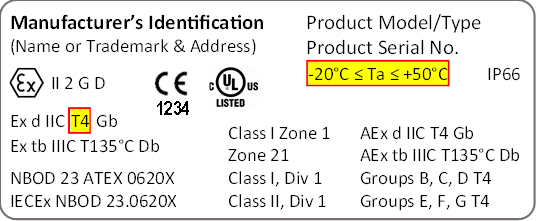 |
| Figure 3: Equipment label with IEC temperature class & ambient temperature range indicated |
Temperature class is defined by IEC 60079-0 (2017) as a “classification system of Ex Equipment, based on its maximum surface temperature, related to the specific explosive gas atmosphere for which it is intended to be used” (Clause 3.85). Group II (see Drill Down #25) electrical equipment must be marked with the symbol indicating the temperature class. The manufacturer may specify the maximum surface temperature between two temperature classes by marking the maximum surface temperature in °C alone, or by marking the maximum surface temperature in °C, with the next highest temperature class in parenthesis (e.g. T1 or 350°C or 350°C (T1)) (IEC 60079-0 (2017), Clause 29.4.d). Figure 3 shows “T4” as the temperature class for the IEC marking, also with a 135°C maximum surface temperature (table 3).
“Equipment designed for use in a normal ambient temperature range of -20°C to +40°C does not require marking of the ambient temperature range. However, equipment designed for use in other than this normal temperature range is considered to be special. The marking shall then include either the symbol Ta or Tamb together with both the upper and lower ambient temperatures or, if this is impractical, the symbol “X” shall be used to indicate specific conditions of use that include the upper and lower ambient temperatures” (IEC 60079-0 (2017), Clause 5.1.1).
Temperature marking requirements vary slightly with older editions of IEC 60079-0, so it is pertinent to match the edition of the standard to the age of the equipment when verifying compliance. Special symbols, such as the “X” mentioned above are to be discussed in Drill Down #29.
IEC 60079-series temperature classes are listed in Table 3.
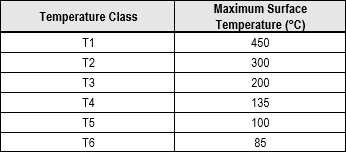 |
| Table 3: IEC 60079 Temperature Classes |
Conclusion
While there are variations between the temperature classes of the three HazLoc marking systems that we have examined, there are two major considerations:
1) Temperature class is relevant to any gases that may be present or expected in a protected location; and
2) All equipment in a HazLoc should be rated to the temperature class with the lowest ignition temperature of the atmosphere expected within the location.
A higher temperature class may be used in place of a lesser class than is required for a HazLoc. For example, if acetylene (305°C ignition temp) is the gas with the lowest ignition temperature present (or expected) in a classified location, T2 is the minimum required temperature class, but T2 through T6 would be satisfactory for that location.
As shown on the example labels, the ambient temperature marking must be included if not within the “normal range” of the respective standard, but may reside separately from the specified marking components.
See the appendix for summarized references.
The next Drill Down in this series will address the equipment protection level (EPL), a marking component that has been mentioned previously in this Drill Down series on HazLoc markings.
Protection Techniques Reference Chart
NFPA 70, Articles 500 and 505; IEC 60079-Series
